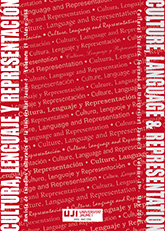Geometría de la seducción: la hermosa cabellera de la Medusa China
##plugins.themes.bootstrap3.article.main##
Resum
Descàrregues
##plugins.themes.bootstrap3.article.details##
S'utilitza una llicència de drets d'autor CREATIVE COMMONS d'accés obert. Aquells autors les obres dels quals siguin publicades per aquesta revista, accepten els termes següents:
- a. Els autors conservaran els seus drets d'autor i garantiran a la revista el dret a publicar primer la seva obra, que estarà simultàniament subjecta a la Llicència de Reconeixement Creative Commons CC BY SA que permet a tercers compartir l'obra sempre que s'indiqui el seu autor i la seva primera publicació.
- b. Els autors podran adoptar altres contractes de llicència no exclusius per a la distribució de la versió publicada de l'obra (per exemple, dipositar-la en un arxiu telemàtic institucional o publicar-la en un volum monogràfic) sempre que s'indiqui la publicació inicial en aquesta revista.
- Els autors poden -i es recomana- difondre la seva obra a través d'Internet (per exemple, en arxius telemàtics institucionals o a la seva pàgina web) abans i durant el procés de presentació, la qual cosa pot produir intercanvis interessants i augmentar les citacions de l'obra publicada.
Referències
Bornay, E. (1994): La Cabellera Femenina: Un Diálogo entre
Poesía y Pintura, Madrid, Cátedra.
―― (2012): «El Simbolismo de la Cabellera Femenina en el Arte»,
Revista de Artes.
http://www.revistadeartes.com.ar/revistadeartes34/arte_el-
simbolismo-de-la-cabellera-en-el-arte.html
Bataille, G. (2010): El Erotismo, Barcelona, Tusquets.
Baudrillard, J. (2011): De la Seducción, Madrid, Cátedra.
Brulotte, Gaëtan & J. Phillips (2006): Encyclopedia of Erotic
Literature, New York, Routledge.
Cen, D. (2001): Zhongguo fashi xisushi 中國髮式習俗史 (Historia del
peinado chino), Kunming, Yunnan Ducation Publishing House.
Chen, G. (ed.) (2002): Poesía Clásica China, Madrid, Cátedra.
Dauncey, S. (1999): The Politics of Fashion: Perceptions of Power
in Female Clothing and Ornamentation as Reflected in the
Sixteenth-century Chinese Novel Jin Ping Mei (Tesis doctoral),
Department of East Asian Studies. Durham, Durham University.
Ding, N. (2002): Obscene Things: the Sexual Politics in Jin Ping
Mei, Durham: Duke University Press.
Douglas, M. (2003): Natural Symbols: Explorations in Cosmology,
London, Routledge.
Eberhard, W. (2000): A Dictionary of Chinese Symbols: Hidden
Symbols in Chinese Life and Thought (Trad. por Campbell, G.
L.). London: Routledge.
Elordy, C. (ed.) (1984): Romancero Chino 詩經 (Shijing), Madrid:
Editora Nacional.
Erudito de las carcajadas. (2010): Jin Ping Mei en Verso y en Prosa
(Trad. por Relinque Eleta, A.) (Vol. 1). Girona, Atalanta.
―― (2011): Jin Ping Mei en Verso y en Prosa (Trad. por Relinque
Eleta, A.) (Vols. 2). Girona, Atalanta.
Firth, R. (1973): Symbols: Public and Private, Ithaca, N.Y, Cornell
University Press.
González de Mendoza, J. (2008): Historia del Gran Reino de la
China, Madrid: Miraguano.
Guan, Y. (2006): Zhongguo toushi wenhua 中國頭飾文化 (La cultura
de adornos para el cabello en China), Hohhot, Universidad de
Inner Mongolia.
Havelock Ellis, H. (1961): Psychology of Sex: a Manual for
Students, New York, Emerson.
Leach, E. R. (1997): «Cabello mágico», Alteridades. 13: 91-107.
Ministerio de Educación de ROC. (1997): Chongbian guoyu cidian
xiudingben 重編國語字典修訂本 (Diccionario lexicográfico chino).
Ministerio de Educación de ROC, Taipei, The Commercial Press.
RAE. (2014): Diccionario de la Lengua Española
Relinque Eleta, A. (2005): «La tradición literaria clásica: de los
orígenes a la dinastía Han», en Martínez Robles D.; C., Prado
Fonts (eds.) (2005): Literatura China. Barcelona, Universitat
Oberta de Catalunya.
Rodríguez González, F. (2011): Diccionario del Sexo y el Erotismo,
Madrid: Alianza.
Sherrow, V. (2006): Encyclopedia of Hair: a Cultural History,
Westport: Greenwood Press.
(1993). Xiaojing 孝經 (The Classic of Filial Piety). Jinan:
Shandong Friendship.
Ye, D, ; L. Ye (2000): Toufa yu fashi minsu: Zhongguo de fa
wenhua 頭髮與髮飾民俗 – 中國的髮文化 (La cabellera y las
costumbres ornamentals del cabello: la cultura china de la
cabellera), Shenyang: Editorial de Liaoning.
Zuoqiu, M. (2002): Xinyi Zuozhuan duben 新譯左傳讀本 (Zuozhuan
con anotaciones) (Ed. por Yu, X. Zhou, F. & Yao M.). Taipei:
Sanming.


